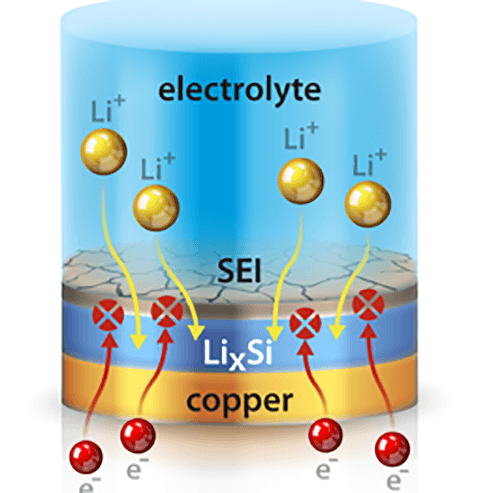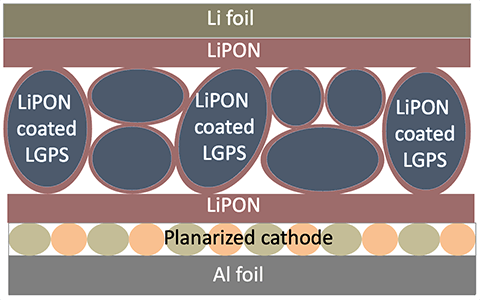Battery Materials Research
NREL's battery materials research focuses on developing model electrodes and coating materials for silicon (Si) anodes, lithium (Li)-metal batteries, sulfide solid electrolytes, and other emerging energy storage technologies.
Mechanistic Studies With Model Electrodes

Fundamental studies of Li-ion storage in electrode materials are critical for the further development of high-performance next generation Li-ion batteries. The complex composition and rough morphology of typical electrodes makes it challenging to gain scientific insights.
Our research focuses on developing model electrodes with well-controlled chemical composition and morphology in thin-film form. These model systems facilitate advance characterization methods and allow us to achieve mechanistic understanding of Li-ion storage in electrode materials such as Li metal or Si anodes.
For more information, see the following publications:
Improving Interface Stability of Si Anodes by Mg Coating in Li-Ion Batteries, ACS Appl. Energy Mater. (2020)
Chemistry of Electrolyte Reduction on Lithium Silicide, The Journal of Physical Chemistry C, (2019).
Surface Engineering of Solid Electrolytes

The properties of solid electrolytes surface play an important role in determining the performance of Li-metal batteries. In this regard, we apply different methods, especially physical vapor deposition, to modify the surface properties of Li-electrode and solid electrolyte materials. We have evaluated the properties of the modified electrode materials through both chemical and electrochemical characterization.
Current research efforts focus on Li-anode coating materials for Li-metal batteries, nitride coatings for sulfide solid electrolytes, and other unconventional battery chemistries.
For more information, see the following publications:
A Review on Lithium Phosphorus Oxynitride, J. Phys. Chem C. (2021)
Investigating the Effects of Lithium Phosphorous Oxynitride Coating on Blended Solid Polymer Electrolytes, ACS Appl. Mater. Interfaces (2020).
Projects
NREL's work on Si electrode materials for Li-ion batteries was funded by the U.S. Department of Energy Office of Energy Efficiency and Renewable Energy, Vehicle Technology Office.
From 2016 to 2020, we worked with the Solid Electrolyte Interface Stabilization consortium. It tackled the barriers associated with the development of advanced Li-ion negative electrodes based upon Si as the active material, with a specific focus on understanding the formation and evolution of the solid electrolyte interphase to solve the calendar life challenge currently limiting the development of silicon anodes.
Contact
Share
Last Updated Jan. 6, 2025
